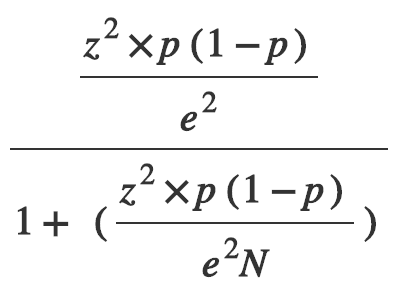Sample Size
How many people should you survey? Choosing the right number of people to survey is a question that often stumps statisticians as well.
But there's good news though. Our sample size calculator is a quick and near-foolproof method for finding the right sample size for your survey.
Enter the population size, confidence level and margin of error to get the right sample size.
Your population size The total number of individuals in the population you want to study.
Confidence level (%) The probability that your sample accurately reflects the attitudes of the population.
Margin of error (%) The percentage points your results will differ from the real value.
Build unlimited 10-question surveys and see the first 100 responses.
Looking to do some market research? You can buy responses using Zoho Survey.
What's a Sample Size?
If you're giving a national survey, you don't have the time or resources to contact every person in the country actually. Instead, you need to pick a small group that's representative of the greater population. This is called 'sample size'.
Let's say you're trying to decide the name for your brand-new product, and have options A and B. Your target market is around 500,000 people, but surveying everyone would be too expensive, so you decide to survey 600 of them—this is your sample size.
Ideally, the sample you end up choosing will be a random group from the whole population.

Sample size and accurate survey results
When you're determining how many survey respondents you need, the actual answer you're looking for is how big the sample needs to be to provide figures that are close to the "real" population.
The choice of sample size is really important for the survey, because the accuracy of your results directly depends on it. There are a lot of things that can affect how well your sample reflects the population—and therefore how reliable and valid your conclusions will be.
Determining the right sample size
Determining your sample size should never be left to guesswork. Here are the main things to focus on so you can get the best sample size and more accurate results for your survey.
- Total population size
- Desired confidence level
- Allowed margin of error
- Confidence level and margin of error
- Mathematical calculation
This refers to the total number of people for whom you're conducting the survey. For example, if you want to find out the sleeping habits of people in Alabama, the total population size would be equal to the state's population. If you want to find the number of holidays people in your company want to take, it would be all of your employees.
Depending on the survey's purpose, the total targeted population may be a huge number, like that of several countries combined. In that case, you may not have the time to survey every person, so you select a fixed number which works with your resources and time.
Keep in mind that it can be difficult to determine the correct sample size—while there is a practical need to cut down on your sample size, you cannot compromise the accuracy of your results. Hence, the objective is to hit that sweet spot where your sample size is just enough to represent your total population.
The confidence level determines how sure you are that your sample's survey results will be close to the ones for the whole population. It's usually placed at 95%.
With a 95% confidence level, a researcher can be certain that any value of the sample will fall in the margin of error 95% of the time. It is not recommended to keep the confidence level below 90%.
Margin of error is a percentage number that shows the random sampling error in your survey results. It indicates the variation that the survey results may have, and is mostly a plus or a minus value. Usually people choose a margin of error of 5%. For example, if your survey results show that 67% of people love country music, you could say that people above and below a range of 5%, i.e, 62-72% of people—known as the confidence interval—love grooving to some country music.
The sample size that we're considering in our online survey is also directly related to the margin of error and confidence level.
Choosing a confidence level and margin of error can be tricky business. Usually, survey researchers will choose a confidence level of 95% (or 99% if more precision is required) and a margin of error of +5%. However, if these two values are too cumbersome for your sample size, you may have to lower your confidence level or raise your allowed margin of error. If you want to know more about the margin of error and how to calculate it, you can check it out here.
Here's a table explaining how each element of the survey will change the result's accuracy depending on whether its value is increased or decreased:
One good rule of thumb is to run a test survey—known as a pilot—with approximately 10% of the sample size that you plan for the actual survey. By piloting your survey, you'll get an idea if your questions are easy to understand, and you can make sure that the answers you're collecting are reliable and valid.
Zoho Survey uses a scientifically sound, well-established formula for calculating the sample size for your survey:

Here, n = population size, e = margin of error (percentage in decimal format), z = z-score.
The z-score implies the number of standard deviations that a given population is away from the mean. To find the right z-score for your survey, use the table below:
Remember that while calculating a smaller sample size, it's necessary to have a larger sample if you're aiming for a larger margin of error. Also, the higher the confidence level you want to have, the larger your sample size will need to be.

Looking for more responses?
If your sample size calculator says that more respondents are needed, Zoho Survey can help you. Get in touch with us, and we can get responses from the exact audience you're looking for. Buy responses makes it easy to get survey responses from people around the world.
It's important to spend time researching the right sample size for your survey, as it can make or break it. The accuracy of your results is directly dependent on your sample composition—so make sure you get it right.
Survey your sample the right way using Zoho Survey.